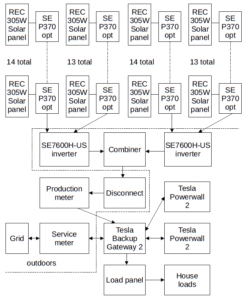
Here is a system description from a block diagram point of view.

Solar panels. On the roof are four strings of solar panels, 54 in total. Most of the panels are REC 305-watt panels (spec sheet). A few of them are slightly higher power panels also made by REC. The panels are on three roofs that are pitched at about 4 degrees. One roof is pitched roughly south, one roughly east, and one roughly north. On average, the roofs are generally pointed nearly straight up. The house is at about 40 degrees north latitude. This means that at noon in summer the sun’s rays might be striking some of the panels at about 23 degrees away from normal. But in winter the sun’s rays at noon are something like 73 degrees away from normal for most of the panels. And of course other times of days the angle is much less favorable. And, given that the panels are nearly level, in winter it is commonplace for the panels to be covered in snow.
In the middle of summer, on a sunny day, the daily production of the array might be 100 kWh.

Power optimizers. Each panel has a Solaredge P370 power optimizer (spec sheet). The idea of these optimizers is that they make up for differences in the productivity from one panel to the next in a string of panels. One of the reasons that this is helpful in this installation is that the panels are on three different roofs that are pitched in three slightly different directions, so the power optimizers compensate for the non-identical productivity of the panels depending on their pitch (given that a particular string may have panels on two different roofs). Another reason that this is helpful is that there might be snow on some panels and not others.

Inverters. There are two inverters. Each is a Solaredge 7600-H-US inverter (spec sheet). Each inverter is connected to two strings, one with 13 panels and another with 14 panels. The inverters together provide 15.2 kW of AC power.

Powerwalls. There are two Tesla Powerwalls. Each is a Powerwall 2 (spec sheet). The two Powerwalls together provide 27 kWh of storage. The inverters in the Powerwalls together provide 10 kW of power.

Tesla Backup Gateway 2. There is one Tesla Backup Gateway 2 (spec sheet). This is the device that connects to the Powerwalls and to the solar inverters and to the house load panel (circuit breaker panel) and to the power grid (the electric company). This is the brains of the system. It does things like this:
- Monitors the electrical power provided by the electric company on the power grid, so that it can disconnect the house from the grid if the grid power has failed. This is a safety feature to protect electric company workers as they work to restore the electric power on the grid. Later when the grid power is restored, it reconnects the house to the grid.
- Sends instructions to the Powerwalls so that they know when to charge and when to discharge.
- Pays attention to reports of imminent bad weather and actively keeps the batteries topped up in case the power might fail during the bad weather.
- Exchanges data-over-powerline messages with any Tesla cars that might be plugged in for AC charging in the house, so that if the house goes “off-grid” the car can be told to stop charging or to charge at a lower rate.
- Pays attention to the time of day so that the system can avoid purchasing electricity from the electric company during peak times and can try as hard as possible to purchase electricity only during the least expensive times.
One Reply to “System description”